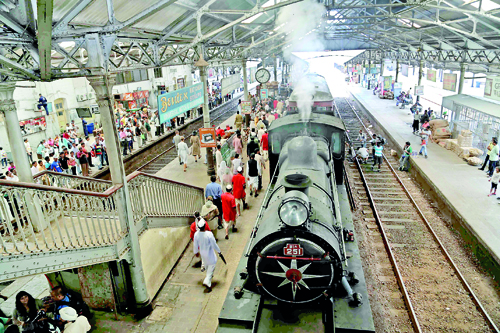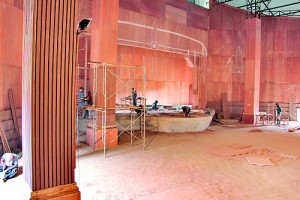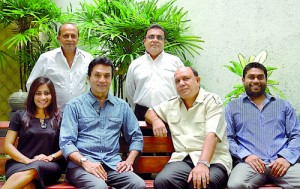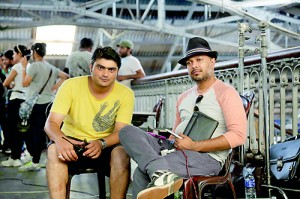Making Mumbai
Very much has been said about the very little information which has slowly seeped out of one of the most eagerly awaited releases from India for this year. Bombay Velvet is Director Anurag Kashyap’s most hyped and talked about film to date and is a nine-year dream finally in the making. With a lot of excitement built for its release date (November 28), Bombay Velvet features familiar names such as Ranbir Kapoor, Anushka Sharma and Karan Johar (appearing in a negative role for the first time and reportedly almost

It could be Mumbai: Fort Railway Station in a scene from the film
unrecognizable in his new avatar). The movie revolves around Mumbai’s ascent as a metropolis and features a love story set in the backdrop of violence, greed, jazz and a rapidly changing cityscape. It was initially inspired by the L.A. Quartet series by James Ellroy and based on Princeton historian Gyan Prakash’s Mumbai Fables.
Prodded by the fact that shooting in Mumbai would be a logistical nightmare and with Mumbai being only a pale shadow of what it used to be (despite the fact that it has a high number of original art deco structures – second only to Miami and Florida), the producers went in search of alternate filming locations. After toying with multiple locations and a flurry of emails exchanged back and forth between the film’s producers in India and a team in Colombo, Sri Lanka was the final pick, beating out cities in South America and India. In an interview with the Times of India, Kashyap cited the relatively low production costs (in comparison to Mumbai), support from the government and similarities in Mumbai architecture as incentives for choosing Sri Lanka.

Built from scratch: The interior of the set created at Ranminitenne Studio
But how do you transpose an entire city (suspended in time, at that) to another country? If the multiple to-do lists scribbled on the enormous whiteboard in their office are an indicator – juggling a vast nexus of logistics is second nature to The Film Team Sri Lanka. With feature films such as Midnight’s Children, Indiana Jones and the Temple of Doom, Water, Jungle Book and Mother Theresa under their belt and armed with a formidable brief, The Film Team began work to recreate and capture the essence of Bombay in the 1950s and ‘60s within Sri Lanka. Filming locations around Colombo included Slave Island’s Nippon Hotel, the Mayor’s house, Shalimar Hotel in Maradana, ‘Walauwa-type’ houses and the Fort Railway Station as well as locations within the Galle Fort.
With the vestiges of Colombo’s old world visage fading away and the ease of filming in a more controlled environment, the decision to recreate old-world Bombay in the National Tele-Cinema Village in Hambantota (which was incidentally re-launched around the same time) was an instantaneous one with little hesitation from the Indian production team. With clear blue skies, considerable support from authorities and favourable weather conditions around the area also tipping the scales, work immediately began to construct Bombay of yore and its trademark linear symmetry of Art Deco buildings within the Tele Village. 
“We started from scratch and cleared a jungle area to fit in this set. I think it was the biggest one built in Sri Lanka so far,” says Art Director and Production Designer Errol Kelly, explaining that the land needed to be levelled and water diverted from canals  before constructions. “I was confident we could pull it off,” smiles Errol, a film industry veteran. From railings made in Kandy, street lamps sourced from Colombo, intricate decorative mouldings crafted from fibre glass to sourcing 50 vintage cars and building a double decker tram car (from scratch), considerable effort was made to capture and crystallize the atmosphere of the time. The end result were streets and buildings with the distinctive Deco-Saracenic style characteristic of Bombay and a plush jazz club with bold interiors and black and white chess-board floors.
before constructions. “I was confident we could pull it off,” smiles Errol, a film industry veteran. From railings made in Kandy, street lamps sourced from Colombo, intricate decorative mouldings crafted from fibre glass to sourcing 50 vintage cars and building a double decker tram car (from scratch), considerable effort was made to capture and crystallize the atmosphere of the time. The end result were streets and buildings with the distinctive Deco-Saracenic style characteristic of Bombay and a plush jazz club with bold interiors and black and white chess-board floors.
Says Gopi Darmaratnam, Production Accountant at The Film Team, “The Indian industry has got to know of it [Sri Lanka’s potential as a film destination]. It was such a hyped project that everyone has got news of it.” While authorities are gradually understanding the potential of promoting Sri Lanka as a film destination and have been supportive, the need to harness said potential and cement Sri Lanka as a strong, sustainable film destination hub in the long run would be more beneficial.
“Sri Lanka, the whole country, is a studio itself,” says Ainsley de Silva – Line Producer/Production Manager, echoing Steven Spielberg’s sentiments when he came to the island two decades ago. So what can Sri Lanka offer to the film industry, that better known destinations can’t? In an interview with the Times of India, director Anurag Kashyap, spoke about a “peace while shooting’” in Sri Lanka and the absence of the usual chaos and clamour which accompanies most productions. While options are limited when deciding locations for shoots, the profusion of waterfalls, rivers, jungles, beaches and colonial architecture outweigh the lack of cityscapes and skyscrapers making Sri Lanka a picturesque destination for the silver screen. Says Ainsley, “Sri Lanka has a lovely geographical situation […] You can move your camps all over the country without losing days of filming and you have everything – from the hill country, water bases, rivers and then the beach – and they’re all beautiful.”
“We have the potential but we don’t get enough publicity,” voices Errol, adding that opportunities are slowly opening up. Perhaps the release of Bombay Velvet may also help in changing that as the elaborate sets which were painstakingly built for the film at a cost of about 250 million Sri Lankan Rupees are still available at the Film Village, in order to encourage visitors and filmmakers.
| Film and pop culture tourism: The big picture
The all-pervasive thoroughness of marketing leaves no stone unturned and tourism as a category has gradually evolved into various subgenres. Sports, eco-tourism, wellness, religious, cultural, adventure, medical and leisure tourism are the more common categories while war tourism and poverty tourism (also tastelessly dubbed ‘poorism’ – cities such as Mumbai and Rio de Janeiro offer ‘slum tours’) are problematic categories, straddling the fine line between exploration and exploitation. Film tourism and pop culture tourism are less controversial genres, linking travel and trends in popular culture. London’s Abbey Road draws numerous tourists trying to replicate The Beatles’ album cover while Albuquerque, New Mexico has given rise to ‘Breaking Bad Tourism’, thanks to the hit TV show. The extraordinary success of Psy’s ‘Gangnam Style’ was every tourism authority’s dream come true as its heralded a 13.4% leap in South Korea’s tourist figures and even prompted ‘Gangnam tours’ – ironical as the song parodies the fast, flashy lifestyle the tours promote. In relation to film tourism, countries such as New Zealand, Malaysia, Singapore, Thailand and Fiji have cemented themselves as film destinations, offering rebates to film makers, seeing the potential that comes in both during and after the production. New Zealand’s success story in relation to ‘Lord of the Rings’ and ‘The Hobbit’ is perhaps an excellent example where the marketing strategy focused on leveraging and converting the attention New Zealand received as a film destination into a travel destination. Years after the success of the LOTR franchise, tourists still flock to New Zealand to catch a glimpse of Middle-Earth and tour film sites. |


